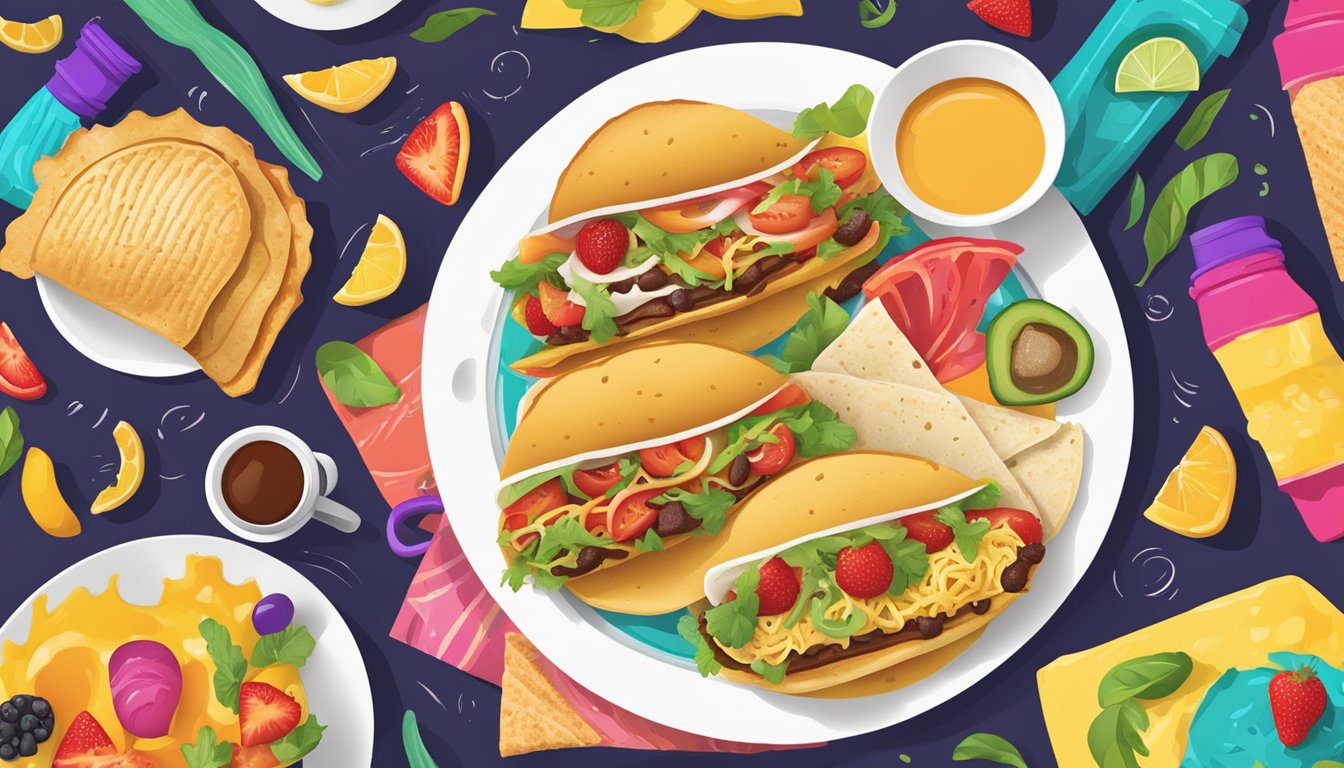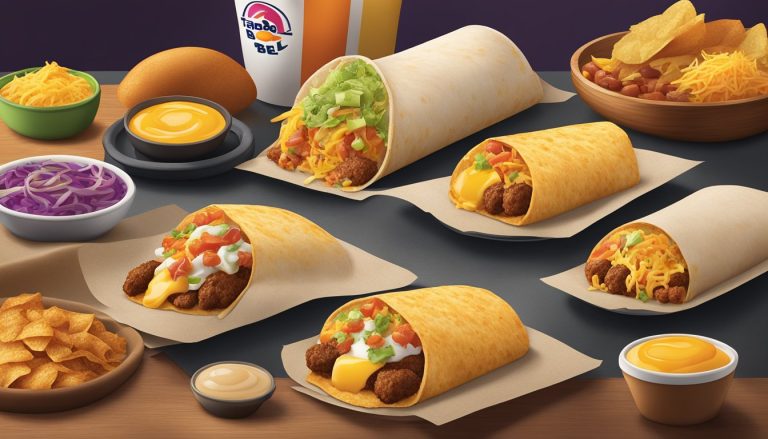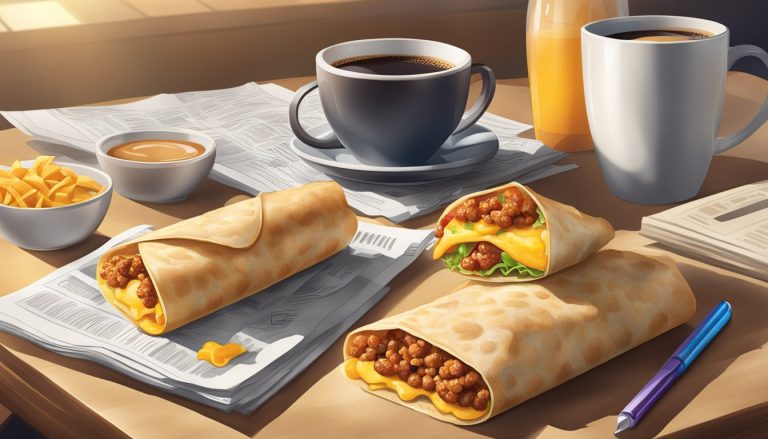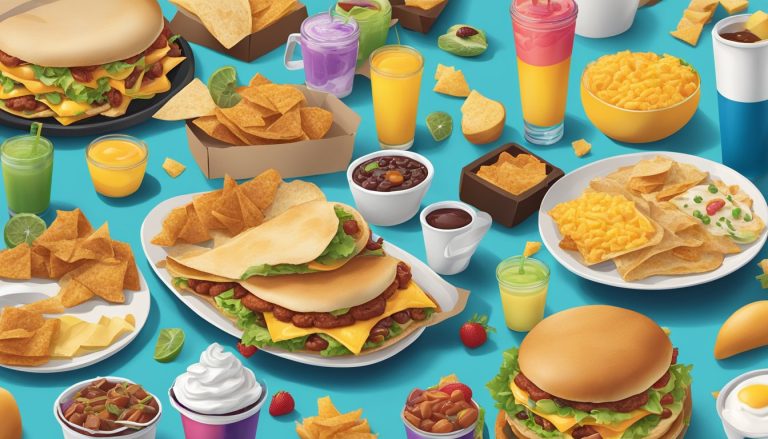Taco Bell’s breakfast menu has become a popular option for morning diners seeking a quick and flavorful meal. The typography and graphic design elements used on this menu play a crucial role in attracting customers and conveying the brand’s identity. The bold, eye-catching fonts and vibrant color schemes employed in Taco Bell’s breakfast menu design help create a visually appealing and memorable dining experience.
The restaurant chain’s iconic logo, which has evolved over the years, sets the tone for the overall aesthetic of their menus. The current logo features a minimalist design with a sleek, modern font that reflects Taco Bell’s commitment to staying current and relevant in the fast-food industry. This design philosophy extends to their breakfast menu, where typography and graphics work together to highlight the unique offerings and entice customers.
Taco Bell’s breakfast menu design incorporates elements of their broader branding strategy, including the playful and distinctive sauce packet font. This font adds a touch of personality to the menu items and creates a cohesive visual identity across all of Taco Bell’s marketing materials. The careful selection of typography and graphics on the breakfast menu demonstrates the company’s understanding of the importance of visual appeal in the competitive fast-food landscape.
The History of Taco Bell
Taco Bell‘s journey from a small stand to a global fast-food giant spans decades of innovation and expansion. The chain’s history reflects America’s growing appetite for Mexican-inspired cuisine and the evolution of the quick-service restaurant industry.
The Founding of Taco Bell
Glen Bell founded Taco Bell in 1962 in Downey, California. Bell’s entrepreneurial spirit led him to experiment with Mexican-inspired fast food after observing long lines at a Mexican restaurant called Mitla Café. He developed a crunchy taco that could be prepared quickly and opened his first Taco Bell location.
The original menu was simple, featuring tacos, frijoles, chiliburgers, and tostadas. Bell’s concept of serving Mexican-inspired food with the speed of a hamburger stand proved popular. The first Taco Bell restaurant had a distinct Mission-style architecture and a logo featuring a sombrero.
Evolution of the Fast-Food Chain
Taco Bell’s growth was rapid. By 1964, the company began franchising, allowing for quick expansion. The chain reached 100 restaurants by 1970.
Throughout the 1970s and 1980s, Taco Bell introduced new menu items like the Enchirito and the Burrito Supreme. These additions helped diversify the menu and attract a wider customer base.
In 1978, PepsiCo Inc. acquired Taco Bell, providing resources for further expansion. By the 1990s, Taco Bell had become a household name with thousands of locations across the United States.
The company also began international expansion, opening restaurants in countries like Canada, China, and the United Kingdom.
Taco Bell and Yum! Brands
In 1997, PepsiCo spun off its restaurant division, which included Taco Bell, KFC, and Pizza Hut. This new entity became Tricon Global Restaurants, later renamed Yum! Brands in 2002.
Under Yum! Brands, Taco Bell continued to innovate. The company introduced concepts like Taco Bell Express for smaller locations and Taco Bell Cantina for urban areas with alcohol service.
Taco Bell’s headquarters moved to Irvine, California, in 2009. The brand has since focused on menu innovation, digital ordering, and sustainability initiatives. Today, Taco Bell operates over 7,000 restaurants worldwide, serving more than 2 billion customers annually.
Brand Identity and Logo Evolution
Taco Bell’s logo and visual identity have undergone significant transformations since the company’s inception. These changes reflect evolving design trends and the brand’s positioning in the fast-food market.
Origins and Significance of the Taco Bell Logo
The original Taco Bell logo debuted in 1962, featuring a simple wordmark in capital letters. It used a sans-serif font in vibrant colors of blue, orange, red, and yellow. This playful design aimed to attract customers and showcase the brand’s energy.
In 1985, Taco Bell introduced its iconic bell symbol. The bell quickly became synonymous with the brand, representing a call to satisfy hunger and enjoy Mexican-inspired fast food.
Rebranding and Its Impact on Brand Recognition
Taco Bell’s most significant rebranding occurred in 1994 with the introduction of the “Think Outside the Bun” slogan. This campaign aimed to differentiate Taco Bell from other fast-food chains.
The logo evolved to incorporate a purple bell icon with a yellow border. This color scheme became instantly recognizable and helped solidify Taco Bell’s unique identity in the market.
Visual Representation through the Years
1985-1994: Bell icon introduced, paired with a bold, italic font
1994-2016: Purple bell with yellow border, “Think Outside the Bun” era
2016-present: Minimalist bell design, adaptable to various color combinations
The current logo, introduced in 2016, features a simplified bell icon. It allows for greater flexibility in usage across different media and locations. The new design incorporates seven vibrant color combinations, enabling adaptability from neon signage to digital platforms.
This evolution reflects Taco Bell’s commitment to staying relevant while maintaining its core visual identity. The logo’s adaptability ensures brand recognition across diverse markets, from Texas to Taipei.
Typography in Taco Bell’s Branding

Taco Bell’s typography plays a crucial role in its brand identity. The restaurant chain has carefully selected fonts that align with its image and appeal to its target audience. Bold typefaces and strategic use of negative space contribute to the brand’s recognizable visual style.
Analysis of the Taco Bell Font
Taco Bell’s current logo uses a sans-serif font, likely Helvetica or a similar typeface. This marks a significant departure from earlier iterations that featured more playful, decorative fonts. The clean lines and simple shapes of the sans-serif font convey modernity and accessibility.
The letterforms are bold and slightly condensed, allowing for easy readability at various sizes. This versatility is crucial for a brand that appears on everything from storefronts to mobile apps.
Legibility and Font Choice
Legibility is paramount in Taco Bell’s typography choices. The brand’s use of sans-serif fonts extends beyond its logo to menu boards, packaging, and promotional materials. This consistency enhances brand recognition and ensures clarity across all customer touchpoints.
The font’s uniform stroke width and open counters (the enclosed spaces in letters like ‘e’ and ‘a’) contribute to its legibility. This is especially important in fast-paced environments where customers need to quickly scan menus or read signage.
Sans-Serif Typeface and Brand Image
Taco Bell’s adoption of a sans-serif typeface aligns with its brand image of being modern, youthful, and innovative. Sans-serif fonts are often associated with simplicity and straightforwardness, qualities that resonate with Taco Bell’s “Think Outside the Bun” ethos.
The minimalist design of the font allows for flexibility in branding. It can be easily adapted for different campaigns or promotions without losing its core identity. This adaptability is crucial for a brand that frequently introduces new menu items and engages in creative marketing initiatives.
Graphic Design Elements

Taco Bell’s breakfast menu incorporates key graphic design elements to create a visually appealing and effective marketing tool. These elements work together to establish brand identity, convey information, and attract customers.
The Role of Color Palette in Marketing
Taco Bell’s breakfast menu utilizes a carefully chosen color palette to enhance its marketing efforts. Purple, a signature color for the brand, features prominently in the design. This distinctive hue helps create brand recognition and sets Taco Bell apart from competitors.
The menu’s color scheme also includes warm tones like oranges and yellows, evoking feelings of sunrise and breakfast time. These colors stimulate appetite and create a welcoming atmosphere. Contrasting elements, such as white text on darker backgrounds, ensure readability and draw attention to important information.
By strategically using color, Taco Bell’s breakfast menu design:
- Reinforces brand identity
- Increases visual appeal
- Improves information hierarchy
- Enhances customer engagement
Minimalist Design and Modern Graphic Trends
Taco Bell’s breakfast menu embraces minimalist design principles and modern graphic trends. This approach aligns with contemporary aesthetics and improves the overall user experience. Clean lines, ample white space, and simple icons characterize the menu’s layout.
The minimalist design:
- Reduces visual clutter
- Enhances readability
- Highlights key menu items
- Creates a modern, fresh look
Taco Bell incorporates current graphic design trends such as flat design and bold typography. These elements contribute to a sleek, up-to-date appearance that appeals to a younger demographic. The use of iconography simplifies complex information, making the menu easier to navigate quickly.
The Intersection of Graphic Design and Branding
Graphic design plays a crucial role in reinforcing Taco Bell’s brand identity on its breakfast menu. The visual elements consistently reflect the company’s overall brand image, creating a cohesive experience for customers.
The menu’s design incorporates Taco Bell’s logo, typography, and visual style guide. This consistency strengthens brand recognition and builds trust with consumers. Custom illustrations of menu items showcase the unique offerings while maintaining the brand’s playful and approachable personality.
Effective use of hierarchy guides customers’ attention to promotional items or new additions. This strategic design approach not only communicates information but also supports marketing objectives by highlighting specific products or deals.
Menu Design and User Experience

Taco Bell’s breakfast menu design plays a crucial role in shaping customer perceptions and driving purchasing decisions. The layout, visual elements, and digital integration all contribute to a seamless user experience.
Taco Bell’s Breakfast Menu Layout
Taco Bell’s breakfast menu layout employs a grid system to organize items into clear categories. Menu boards typically feature large, high-quality food images alongside concise item descriptions. Prices are displayed prominently, often in a contrasting color or larger font size.
The menu uses a hierarchy of information, with popular items or limited-time offers highlighted at the top. This strategic placement draws attention to key offerings and simplifies decision-making for customers.
Effectiveness of Visual Elements on Menu Readability
Visual elements on Taco Bell’s breakfast menu enhance readability and appeal. The brand’s signature purple and bell logo create instant recognition. Bold, sans-serif fonts ensure text is easily legible from a distance.
Color coding helps differentiate menu sections, such as value items or combo meals. Icons and symbols are used to denote dietary information or meal customization options.
High-contrast color schemes, like white text on dark backgrounds, improve visibility in varying light conditions. This is particularly important for drive-thru menu boards.
Mobile Ordering and Digital Menus
Taco Bell has embraced digital technology in its menu design. The mobile app features an intuitive interface that mirrors the in-store menu layout. Users can easily browse, customize, and order breakfast items with a few taps.
Digital menu boards in restaurants allow for dynamic content updates. These screens can showcase promotional items, adjust pricing in real-time, and display calorie information as required by law.
The app’s personalized recommendations based on order history enhance the user experience. It also offers exclusive deals and rewards, incentivizing mobile ordering.
Taco Bell Menu Offerings and Innovations

Taco Bell’s menu reflects a blend of traditional Mexican-inspired fare and creative culinary twists. The chain continuously introduces new items while maintaining its core offerings.
Signature Items and Culinary Creativity
The Crunchwrap Supreme stands out as a Taco Bell icon, combining a flour tortilla with a crunchy tostada shell. Tacos remain a staple, with variations like the Doritos Locos Tacos featuring flavored shells. The Quesalupa merges a chalupa with a quesadilla, showcasing the brand’s innovative approach.
Burritos and quesadillas offer customizable options, while nachos provide shareable choices. The Gordita Taco presents a softer shell alternative. For those seeking lighter fare, the Taco Salad delivers a fresh option.
Taco Bell’s beverage selection includes the exclusive Mountain Dew Baja Blast, a tropical lime-flavored soda created specifically for the chain.
Collaborations and Special Edition Menus
Taco Bell frequently partners with other brands to create limited-time offerings. These collaborations often result in unique flavor combinations and generate buzz among consumers.
The chain has introduced decade-themed menus, bringing back fan favorites from different eras. For example, the ’90s Beef Gordita Supreme and ’00s Caramel Apple Empanada have made temporary comebacks.
Seasonal items and holiday-themed specials regularly appear on the menu. Taco Bell also experiments with regional flavors and international-inspired dishes to keep its offerings fresh and exciting.
Taco Bell’s Cultural Impact and Expansion

Taco Bell has transformed from a local California eatery to a global fast-food powerhouse. Its innovative marketing and unique menu offerings have solidified its place in popular culture.
From a Single Location to a Global Phenomenon
Taco Bell’s journey began in 1962 when Glen Bell opened the first location in Downey, California. The company’s rapid growth was fueled by its franchise model and acquisition by PepsiCo in 1978. By the 1990s, Taco Bell had become a household name across the United States.
The chain’s expansion continued internationally, with locations opening in Canada, Australia, and Europe. Taco Bell adapted its menu to local tastes while maintaining its core offerings. In Australia, the brand collaborated to create a Vegemite Taco, showcasing its ability to blend with local cultures.
Taco Bell’s digital presence has grown significantly. In Q4 of the previous year, the company saw a record 31% digital mix, up 7 percentage points year-over-year. This digital prowess has helped Taco Bell stay connected with younger consumers and drive sales growth.
The Las Vegas Strip Cantina Flagship Restaurant
Taco Bell’s Las Vegas Strip Cantina Flagship Restaurant represents a bold step in the brand’s evolution. This unique location offers an upscale dining experience while maintaining the essence of Taco Bell’s menu.
The Cantina features exclusive menu items, a full bar, and a retail shop. Its design incorporates modern aesthetics with nods to Taco Bell’s heritage. The restaurant has become a popular destination for tourists and locals alike.
This flagship location serves as a testbed for new concepts and menu items. Its success has led to the opening of similar Cantina-style restaurants in other major cities, further elevating Taco Bell’s brand image.
Subway vs. Taco Bell: A Comparison
While both Subway and Taco Bell are major players in the fast-food industry, they have distinct approaches to menu offerings and brand positioning.
Subway focuses on customizable sandwiches and promotes a healthier image. Taco Bell, on the other hand, embraces its role as a “cultural rebel” with bold flavors and innovative menu items.
Taco Bell’s marketing strategies often involve pop culture tie-ins and social media campaigns. The brand’s collaboration with LeBron James to “liberate” Taco Tuesday demonstrates its ability to tap into current trends.
Both chains have expanded globally, but Taco Bell faces unique challenges in adapting its Mexican-inspired menu to diverse international markets. Despite this, Taco Bell’s creative menu adaptations have helped it gain traction in new territories.




